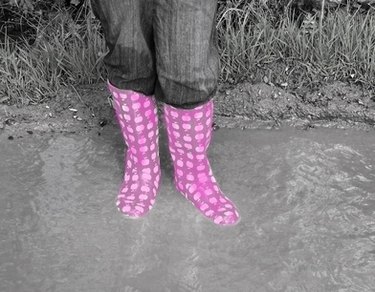
At its most benign, improper drainage can leave your lawn and walkways riddled with puddles. In other cases, poor drainage can cause more severe problems and even lead to foundation damage. Installing a French drain is often a viable solution for those with minor to moderate drainage issues. Where appropriate, French drains offer a simple, affordable and effective fix for pooling landscape water.
French Drain Benefits
Video of the Day
French drains are particularly well-suited for do-it-yourself installation because their design is so simple. At its core, a French drain is little more than a perforated tube placed inside a trench. Installed on a slight incline, this tube carries excess water away from areas where too much moisture can be a nuisance or cause damage. Since French drains rely only on gravity to do their job, they can perform well for many years with little or no maintenance requirements.
Video of the Day
French Drain Design
The dimensions of the trench you dig, the angle the perforated pipe is placed on and the fill you choose to cover the pipe can all vary by site. Generally, the bottom of your trench will be lined with a layer of gravel that the perforated pipe will rest on. This underlying gravel raises the pipe enough to keep it from becoming clogged by dirt and grit from below. Once the perforated pipe or tubing is in place, the rest of the trench will then typically be filled in with more gravel. Since gravel readily allows water to pass through it, excess rain will quickly be directed down to the pipe where it will be carried away to a more appropriate location, like a soak-away or dry well.
Perforated Tubing/Pipe for French Drains
The perforations in your pipe or tubing should be slits or slots rather than circular holes. Both circular and slotted holes will allow excess water to enter your perforated pipe, but narrow slots do a better job of keeping out dirt and other debris that circular holes may allow to enter, increasing the chance of a clog. Many find that encasing perforated pipe or tubing with a fabric slip (sometimes referred to as a "sock") before it is put in place further reduces the amount of dirt and debris that enter the drain, allowing for better performance over a longer period of time.
Face Perforations Downward
French drains cannot function if they become clogged. If the perforations in your pipe or tubing face upward, silt, sand, dirt and other kinds of debris can be carried into your drainage pipe by gravity alone. The simple solution to this problem is to face the perforations in your pipe downward. Water will still be able to enter the perforations from below, but larger particles that may cause clogs will have a much harder time gaining entry.
French Drain Dimensions
For most residential applications, a 4-inch diameter drainage pipe fits the bill very well. Trench width and depth can (and will) vary from one situation to the next, but you always want to make sure you have got a 2- or 3-inch buffer of gravel surrounding your pipe. This includes above and below the pipe, too; keeping your pipe surrounded by gravel on all sides reduces the chances of contact with clogging debris, so don't forget this buffer zone. While some recommend that the diameter of the drainage pipe and the gravel buffer are the only two determining factors in the width of your trench, having a little wiggle room is never a bad idea. It is not only easier to work in a wider space, some claim that wider trenches are also easier to grade and dig.
Other Drainage Fixes
While installing a French drain may be the only task required to fix a drainage issue, installing or clearing rain gutters, changing the slope of land that contacts a structure or even utilizing rain barrels can all play an important role in keeping excess water from being a nuisance or damaging your property.